
COMPARISON OF THE VINTAGE AND MODERN SUB
© Dr. Peter McClean Millar - March 2011

In the annals of watch history there are a few watches that are deservedly recognised as being iconic. Watches that are instantly recognisable and desirable by many people. I could name quite a few but some of the ones that make my top ten list include; the Omega Seamaster, the Rolex Submariner, Eddie Platt's Dreadnought and of course the Doxa SUB 300T. I've owned all of the watches in the previous list and I think I became a legend in my own lunchtime because of the Doxa and even though I have more watches than any man should have, I keep coming back to my vintage SUB 300T. Why? Well It's actually hard to define why exactly. Oh sure, I can wax lyrically about the design, the orange dial, the size and Tonneau case and comfort, but there is more to it than that. The Doxa SUB 300T is more than the sum of its parts. It really is a watch where 2 + 2 = 5.
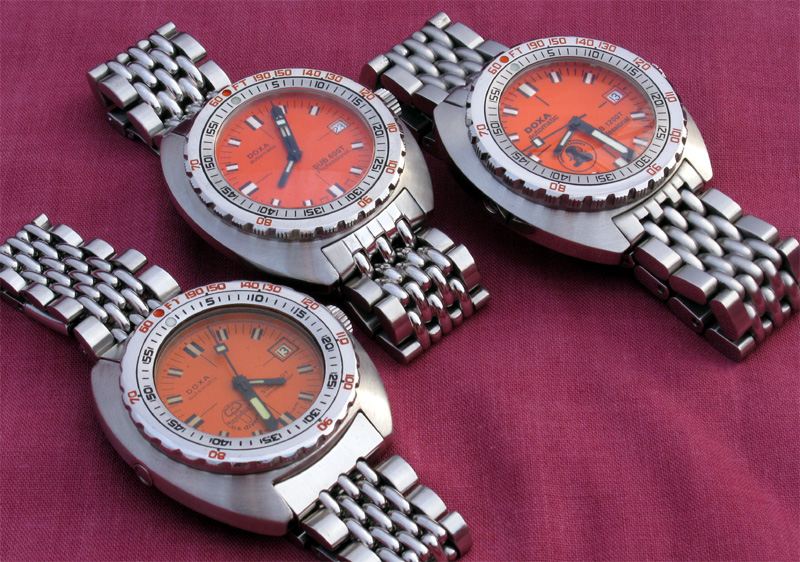
We all know how the Doxa SUB was discontinued in the late 1980's and wasn't produced again until 2002 with the release of the SUB 300T Reissue. However, the design wasn't exactly true to the size and shape of the vintage SUBs. It wasn't until the advent of the SUB 600T that Doxa produced a dive watch that to all intents and purposes looked and felt like its vintage forefather. Subsequent generations such as the SUB 1000T and 1200T have followed the same design specifications with little tweaks here and there, each one being touted as being as close to the vintage SUB as it could get. I haven't included the SUB 750T in this series as it used a larger case. As I have the vintage SUB 300T, the SUB 600T and the SUB 1200T, I thought it was worth comparing them to see what the differences really are and if any do actually come close to being a true replacement for the vintage SUB 300T.
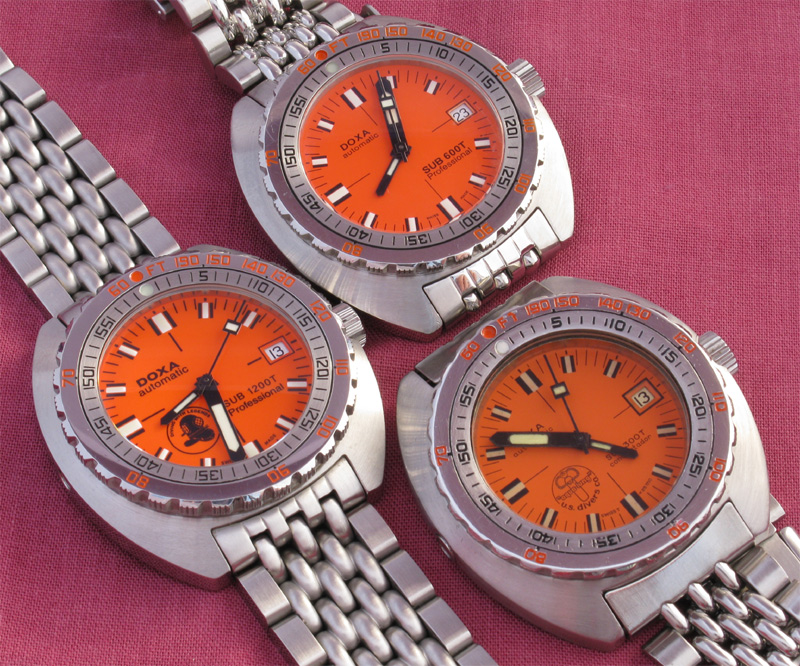
The first thing to do is get the tape measure and scales out and measure them. The following table shows how they stack up. Because of the differences in bracelets the weight is for the watch head only.
| WIDTH mm (inc crown) | LENGTH mm | HEIGHT mm | LUG WIDTH mm | DIAL WIDTH mm | WEIGHT grams | |
| VINTAGE SUB 300T | 45 | 45 | 13 | 20 | 28 | 83.8 |
| SUB 600T | 45 | 44.5 | 13.5 | 20 | 28 | 81.9 |
| SUB 1200T | 45 | 45 | 14.5 | 20 | 28 | 92.6 |
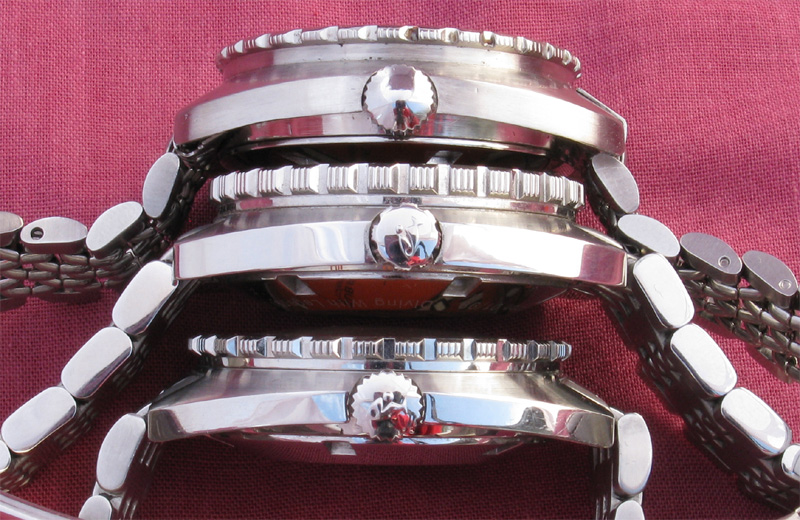
| CASE THICKNESS mm | HEIGHT TOP OF BEZEL mm | HEIGHT TOP OF CRYSTAL mm | |
| VINTAGE SUB 300T | 7.5 | 13 | 13 |
| SUB 600T | 6 | 12.5 | 13.5 |
| SUB 1200T | 6 | 14 | 14.5 |
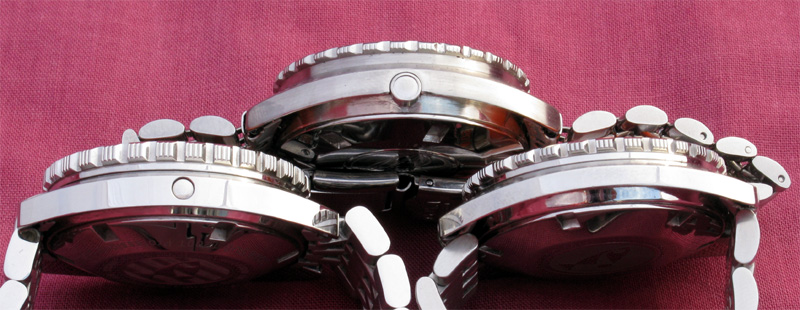
| BEZEL THICKNESS mm | CASEBACK THICKNESS mm | |
| VINTAGE SUB 300T | 3 | 2.5 |
| SUB 600T | 3 | 3.5 |
| SUB 1200T | 4 | 4 |
It's when you actually split the watch into its main components; crystal, bezel, case and caseback that you begin to see that there are some significant differences in the 3 generations of SUB. Anyone who has a SUB 1200T will not be surprised to find that the bezel and caseback are the thickest. What is surprising is that the actual case is much thinner than the vintage model and is the same thickness as the 600T. The fact that the case is thinner than the vintage model begins to explain why the HRV on the 1200T is offset vertically on the curved side of the case (see previous image). I always felt that this was just sloppy design but given that there is an inside bevel on the case (best seen in next image), I believe if the HRV hole had been drilled centrally on the curved side, the channel would have broken through that bevel. Hence the drilling had to be offset upwards. When you look at how the HRV was implemented in the vintage model, it now seems like such an elegant solution. In fact given that the inside bevel is steeper on the vintage SUB compared to the moderen versions, it would have been almost impossible to mount a HRV without using the solution that Doxa chose.
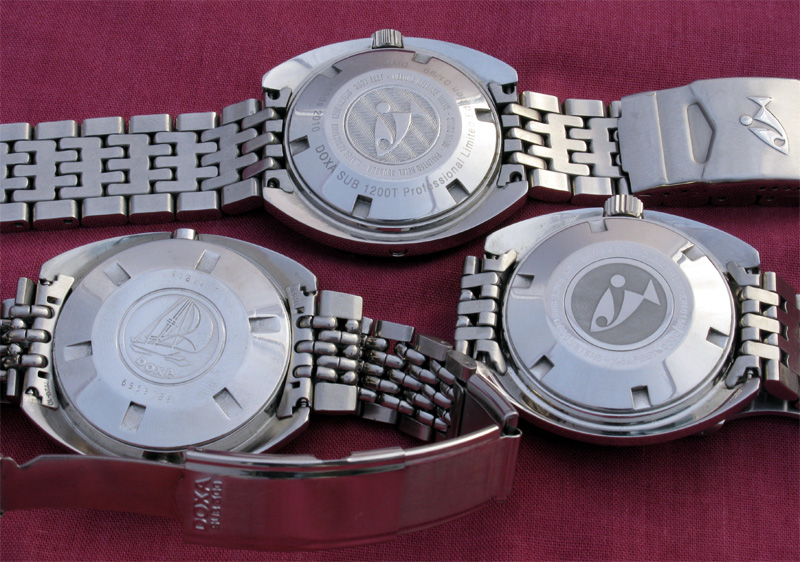
The above photo also illustrates how the caseback has changed over the 3 generations. Not only has it increased in thickness from 2.5mm to 3.5mm to 4mm on the SUB 1200T but the actual flat contact area has reduced from 2.5mm(300T)diameter to 2.4mm(600T) to 2.3mm(1200T). This may not sound like much but the loss of contact area, increased caseback height and increased overall watch height, forced the center of gravity of the watch higher and ultimately means that the 1200T will not sit as well as the vintage 300T on a wrist. For many people this is not a problem. It depends on the size of your wrist and a person's anatomy around the radius and ulnar bones and the forearm flexor muscles and tendons. For some people the back of the wrist is relatively flat but for others it is more rounded and a watch with a higher more rounded caseback and higher center of gravity will tend to "wobble". Unfortunately, I happen to be one of those people who not only like but also needs a flatter caseback. The problem can be mitigated to a certain degree by using a thicker, heavier bracelet, which is what Doxa did when they moved from the SUB 1000T to the 1200T. The belief was that the caseback thickness was increased to accomodate setting the movement lower in the watch. Looking at the numbers above, an easier option would have been to increase the actual case thickness allowing for a flatter caseback and horizontal centralising of the HRV.
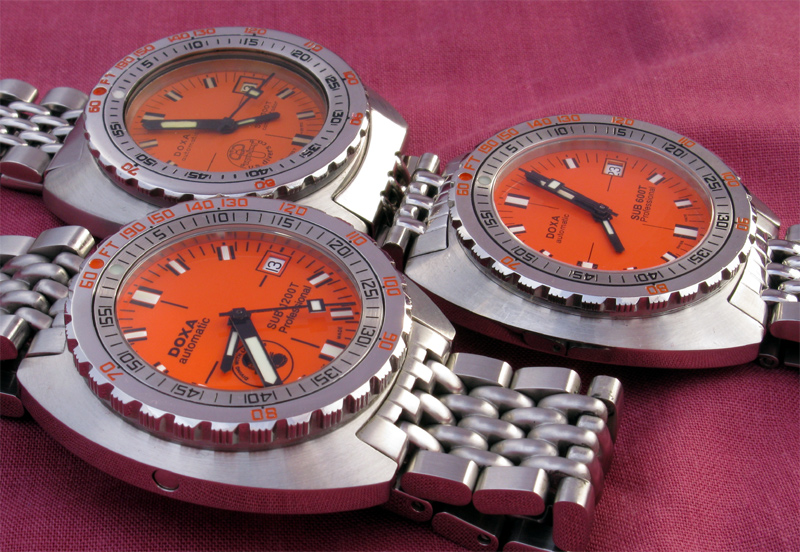
And that brings us to the bezels and crystals. As can be seen from the photos the serrated gripping area of the bezel has increased dramatically over the years. The theory here being that the larger serrated surface makes it easier to grip and turn the bezel with heavy gloves. To be honest here, I can't say that I have found much difference using several different gloves to test the bezels. The major difference which seems to make the 1200T bezel easier to turn is an increase from 60 clicks on the 300T and 600T to 120 clicks on the SUB 1200T. Traditionally the SUB 300T vintage models all used flat toughened glass crystals. The same was true for the SUB 300T Reissue, however, with the 600T, Doxa went for a domed Sapphire crystal. For many people a domed crystal makes a dive watch better looking. For others, especially those who spend most of their day in offices with overhead lighting, domed crystals tend to catch the light reflection more and can make reading the dial a bit more difficult. Both flat and domed crystals each have their pluses and minuses and really it comes down to personal preferences. The one thing that is definitely worse about high domed crystals is that they are more prone to knocking and scratching. For the SUB 1200T, Doxa reduced the curvature and although not quite flat it is a good compromise.
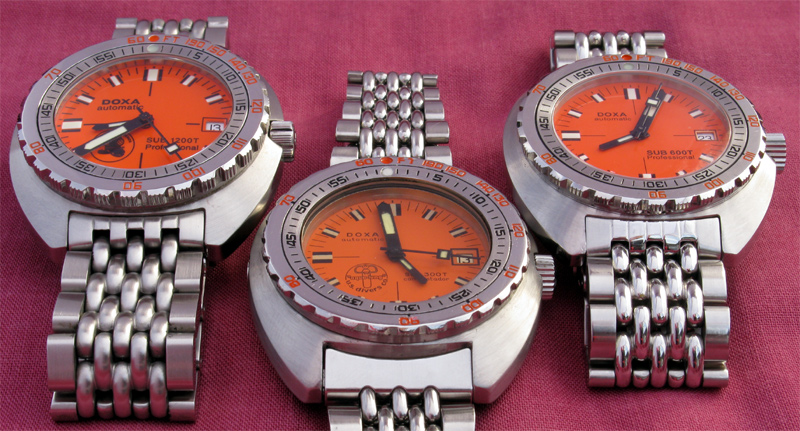
One other major difference between the vintage SUB and the modern incarnation is depth of dial. Look at the dials on in the image above and then at the close up below.
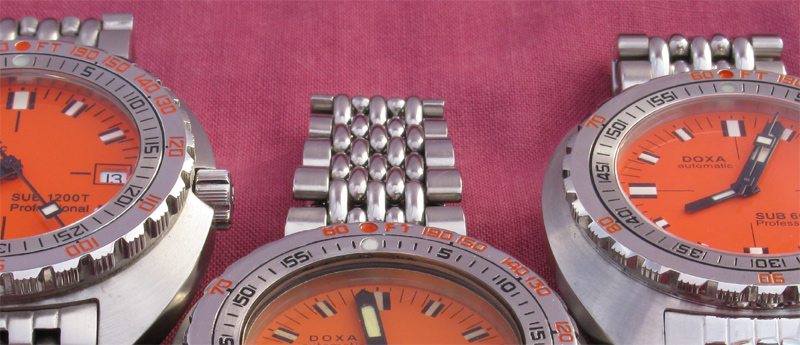
I think it is quite easy to see how much more the vintage SUB 300T dial is sunk deeper into the watch. Without pulling the SUB 1200T apart to look at the size of the chapter ring, it is impossible to say if the dial is actually close to the crystal or it is an effect of the thicker and more domed crystal.
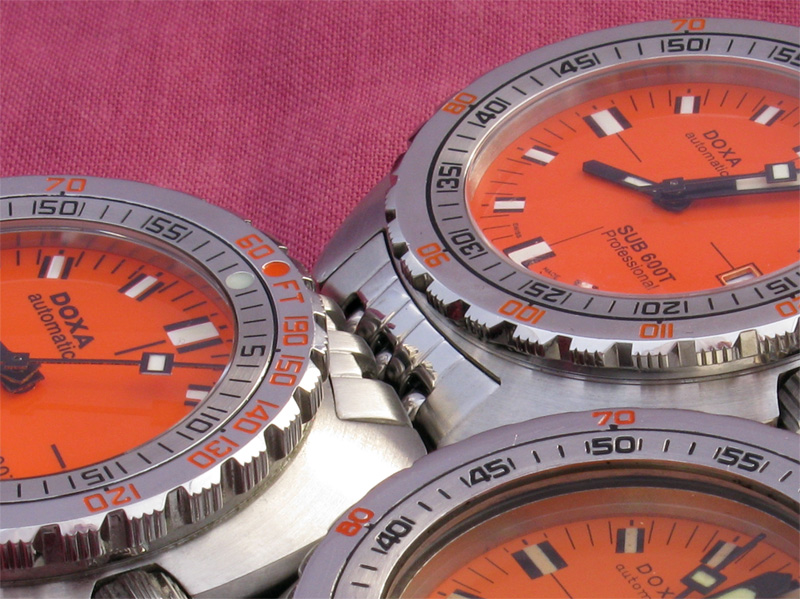
Certainly looking at the 1200T face on it looks as if the dial is deeper than when looked at from the side but it may be due to the crystal magnification rather than the actual position.
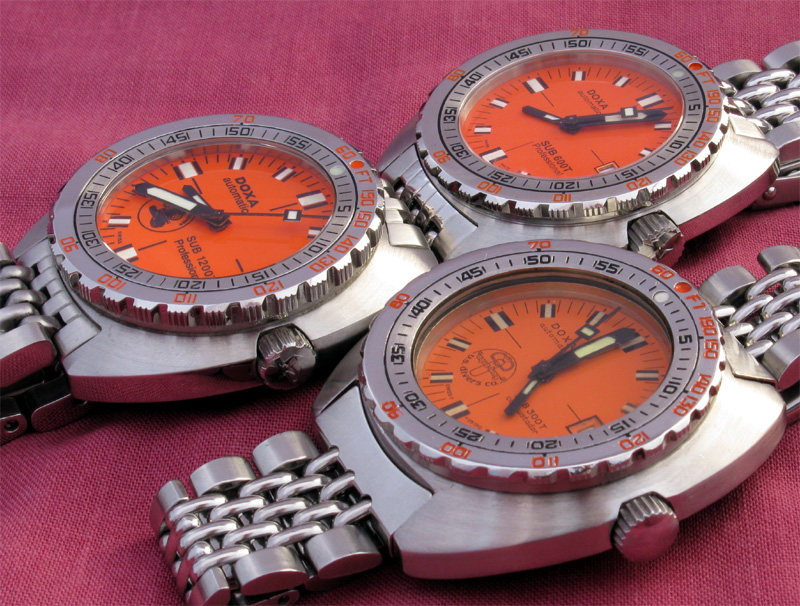
One other difference between the vintage and modern cases which is usually overlooked unless you have both variations of watch sitting side by side is the case cutaway for the screwdown crown. On vintage models, Doxa sometimes used a sealed crown rather than screwdown version. Both were rated for 300 meters (1,000 feet) but the screwdown crown was preferred as it was deemed to give an increased assurance that the crown wouldn't leak at depth. As can be seen from the photo above, the modern SUB cases have a deeper notch cut into the side of the case. The outside gripping surface of the crowns have also gone through a metamorphosis over time. From relatively blunt serrated edge on the 300T to fairly sharp ridges on the 600T to a similar profile to the bezel on the 1200T.
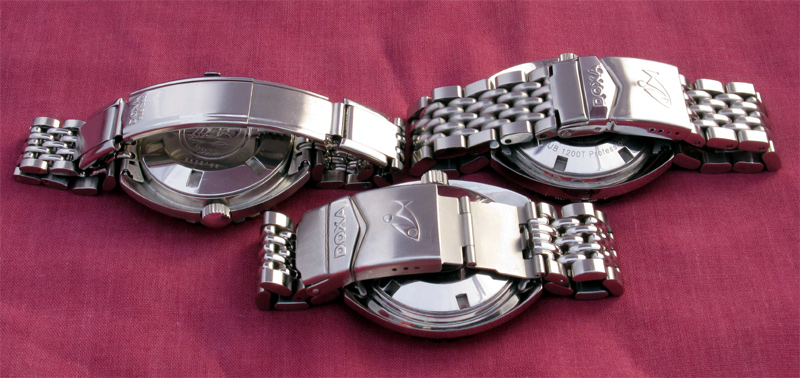
The Doxa SUB is undoubtedly famous for its orange dial and Non Decompression bezel, but one must not forget the rice bead bracelet and ratcheting clasp and expanding side pieces. 45 years ago the bracelet was just as innovative as the watch. The ratcheting clasp made for easy adjustment when using with a wetsuit and the springloaded side pieces naturally compensated at greater depth as the wet suit compressed. Unfortunately the bracelet was maybe not as robust as it could have been and although the clasp was beefed up in later years very few complete and functioning bracelets have survived. With the 600T, Doxa wanted to maintain the look and feel of the vintage bracelet but give it far greater strength. They succeeded admirably with the solid links which looked like the vintage ricebeads and the more traditional folding wetsuit extension. This bracelet was further developed which resulted in the SUB 1200T bracelet which was much thicker, used solid endlinks and was matt finish rather than polished. Many people welcomed the thicker bracelet and sold end pieces but the matt finish tended to make the bracelet look unfinished. It is not uncommon for people to take a Dremel and polish the links in keeping with the 600T version.
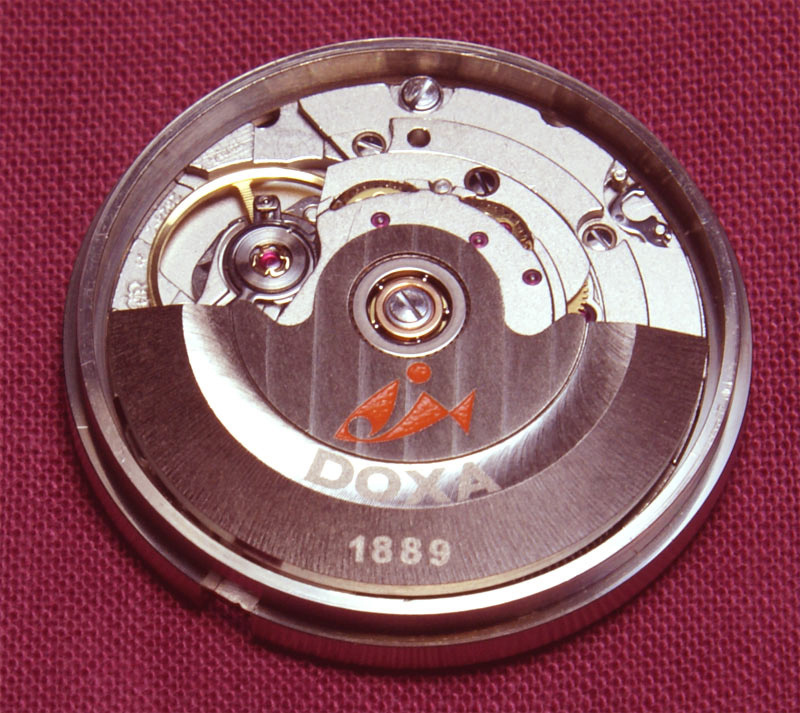
And that pretty much just leaves the movements. Virtually all the modern non chronograph or GMT SUBs use the tried and tested 25 jewels, ETA 2824-2 movement. This is a modern version of the original SUB 300T's 17 Jewel ETA 2852 movement. It is rated at 42 hours power reserve, 28800 bph with an Incabloc anti-shock system and has been produced since 1972. This movement is the workhorse in a number of watches at all price levels and has a reputation for reliability and robustness. Its popularity virtually ensures that parts should be available for a long time to come and any watchmaker should be able to service or adjust it without a problem. The major difference between it and the vintage movements is its ability to change the date independently as opposed to winding the hands a complete 24 hour rotation to change the date. One of the great things about the vintage Doxa SUBs is that it is still relatively easy to pick up spare movements or have existing ones serviced. Most of these watches are now over 40 years old but they are still running and able to be kept running for many years to come. It will be the same with the modern Doxas because the ETA 2824 movement is so ubiquitous.
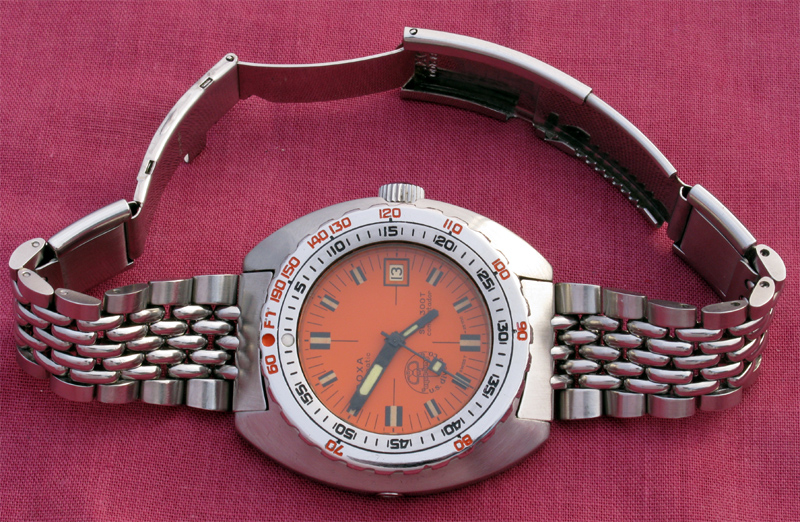
Well, I guess what started out as an essay to show how alike the vintage and modern Doxas were actually turned out to show just how different they really are. Is that a bad thing? Not really. You have to consider that the SUB 1200T was made almost 45 years after the first SUB 300T and the world has moved on greatly in those years. In the late 1960s Scuba diving was still a relatively new sport and it was crying out for a dive watch like the Doxa SUB. In those days, literally, your life could depend on your dive watch. Nowadays we have dive computers, rebreathers and a level of sophistication and technology that could only be dreamed of back then. The modern dive watch world is now driven by other things outside of necessity. Those things include; marketing to non divers, bigger watches, deeper depth ratings and and increased competition between watch companies to make the "best" dive watch. A dive watch is no longer just for divers, we have people from all walks of life who wear them, including one famous orange Doxa wearing chef who probably couldn't tell the difference between a regulator and a beef risotto. Again, is that a bad thing? Absolutely not. I just hope he bought my Doxa book.....ha, ha, ha. Seriously, though. The world has changed and the more it changes the more we hanker for the simplier, good old days. In many ways the modern Doxa SUB is an acknowledgenment of the vintage SUB and what it has achieved but with modern materials and upgrades. Could Doxa have taken a vintage SUB 300T and made an exact copy of it (except for the movement)? Yes they certainly could. Would their management allow such a thing? I'd hazard a guess no. Probably because making a watch with a depth rating of 300 meters would seem like a retrograde move, especially as everything is now bigger, stronger, deeper. This in itself is a nonsense as realistically a dive watch rated to 300 feet is far more than it would ever need to be. I think that is a great pity and if I was running the company I'd make the next anniversary SUB (say 45 years) a clone of the vintage SUB 300T Conquistador except using a modern polished ricebead bracelet. I'm probably in the minority, but it is a nice dream.